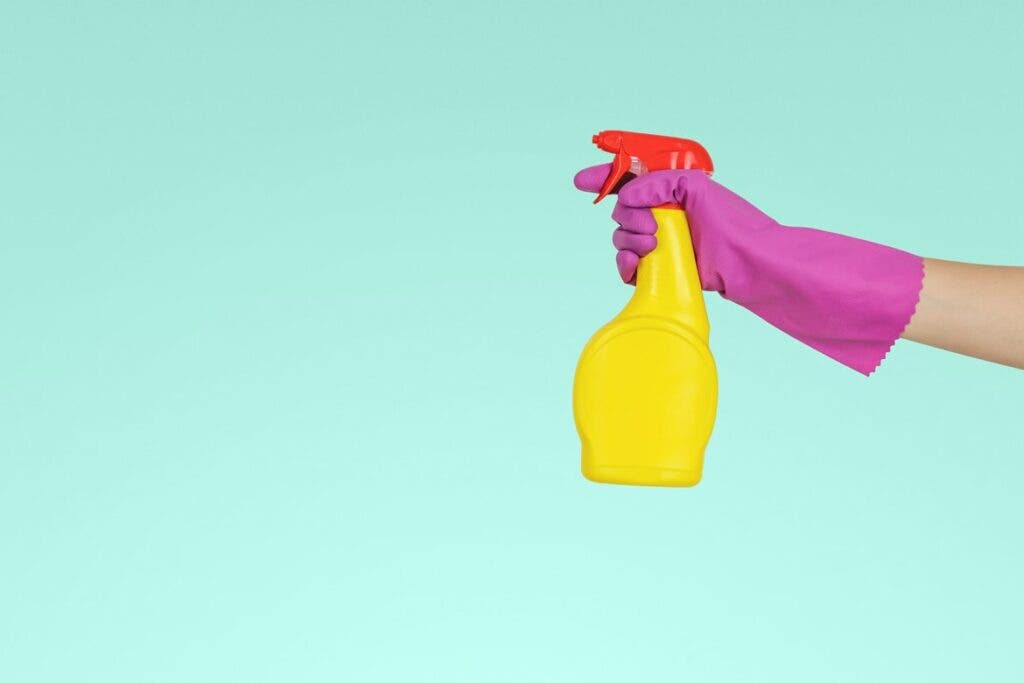A study explicitly aimed at cleaning professionals and staff using COVID-19 antibacterial aids found that these workers could inhale more airborne pollutants than those produced by exhaust fumes in a busy urban street.
According to the scientists, these employees also face extra danger as they work in enclosed areas which are more likely to help the production of dangerous aerosol particles known to damage the respiratory system.

Particle-based pollution, small pieces of liquid or solids in the air, is thought to result from the primary or direct emission of volatile organic compounds (VOCs). It can cause irritation, headaches, damage to organs, or in the long run, cancer. Additionally, this type of pollution occurs indoors, it can react with other compounds or ozone in the atmosphere to form harmful secondary organic aerosols (SOAs).
SOAs are essentially a suspension of minute solid or liquid particles in the air. They’re formed from human activity as a form of unnatural pollution that stays in the earth’s atmosphere and influences the climate as well as human health. Overall, SOAs make up a significant proportion of the aerosols contained in the troposphere
In general, the severity of health risks associated with aerosols is correlated with the size of the suspended particle to cause diseases ranging from asthma and bronchitis to long-term conditions such as cancer. Indoor, SOA concentration is influenced by the amount of ventilation to the room or air conditioning systems.
However, we don’t yet know all that much about the medical conditions that SOAs formed indoors can produce, and neither about the dangers posed to regular users of sanitation products in enclosed environments (in this case, professional cleaners). This is where the new study comes in.
Indoor pollution is just as dangerous as outdoor pollution — if not more so
To fill this gap in our knowledge, scientists from the University of California, Davis, have just published a study in Science Advances that mimics the work conditions for these workers in real-time.
Findings show that commercial products used for sanitizing indoor surfaces may deposit small pollutant particles into human respiratory tracts at rates higher than aerosols from vehicles. This could be very impactful, for instance, for people who have worked heavily with disinfectants during the coronavirus pandemic.
Colleen Rosales, atmospheric and air pollution chemist at the University of California, Davis, and lead study author, says, “One perturbation that humans introduce to the indoor environment is the use of household cleaning and disinfection products, some of which have “natural” scents, such as citrus or pine.”
Adding healthcare systems worldwide should ready themselves for mild to chronic health conditions that are only now symptomatic.
“Workplace and residential exposures resulting in adverse health effects are likely to be influenced by increased chemical disinfection of indoor surfaces during the coronavirus disease 2019 pandemic,” Rosales adds.
Despite this, VOCs are widely used worldwide-emitted by a wide array of products numbering in the thousands-consumables such as paints, varnishes, and wax all contain these chemicals, as do many cleaning, disinfecting, cosmetic, degreasing, and hobby products.
Pollution causing products in your home
To investigate SOA formation indoors, the US team focused on monoterpene – a compound known to produce VOCs and SOAs from various sources, including cooking, foodstuffs, plants, and multiple kinds of fragranced products.
The team used this product to mop the surfaces of a ventilated room in a research building situated in a forested area for 12 to 14 minutes – measuring the formation of primary VOC emissions and SOAs in real-time as they did so.
After the scientists collated the readings, they calculated that a person using a monoterpene-based cleaning product inhales about 30 to 40 micrograms of primary VOC emissions per minute at the start of mopping. After which, they would inhale 0.1 to 0.7 micrograms per minute of SOAs as the product begins to react with other compounds in the air.
In laypeople’s terms, these measurements indicate that exposure during 1.5 hours of mopping is equivalent to exposure to traffic in an urban street for 1.5 to 6 hours – a particular concern for janitors and building cleaners who clean surfaces in indoor environments.
Even surface residues in the home present a danger
However, the team concedes that due to the volatile nature of monoterpenes (found both outdoors and around the home at a constant level) the data in the study may have been influenced by ventilation to the outdoors or cleaning products previously used around the building. However, they note that the current study only recorded new VOCs and SOAs, giving a realistic view of how these compounds react with newly applied cleaning products and those left as residues around the building.
Annele Virtanen, an atmospheric professor at the University of Eastern Finland, who wasn’t involved in the study, noted the importance of understanding the impact of these aerosols.
“SOA accounts for a major fraction of the global atmospheric aerosol burden. Understanding the mechanism of formation and the properties of SOA is therefore important to estimate its effects on climate, air quality, and human health,” Virtanen wrote in a special issue on MDPi.
The authors also suggest ensuring indoor levels of ozone are below 1 part per billion before cleaning, which could minimize the number of resultant pollutant particles. Employers could achieve this by keeping windows closed, especially on warm and sunny days with little or no wind, and running an air purifier that can remove ozone in your home, either with a carbon filter or PECO technology.
Wearing a filtered mask may also help protect professionals until more environmentally friendly ergonomic cleaning products come to market — whenever this may be.
Was this helpful?



